Chapter 3 Air Pressure Notes
An important element as well as one of the basic elements of weather and climate is air pressure.
Air is made up of a number of mixed gases and it has weight. The weight of a column of air above a given place determines the air pressure at that place.
Air pressure is much more important than climatic control because small pressure changes are the cause of winds which may induce remarkable variations of general weather conditions. It is very significant in our daily life.
Read and Learn More WBBSE Notes for Class 7 Middle Class Geography
Does air exert pressure?
All materials and all forms of life, including man are affected directly by the slight air pressure exerted on it.
Air exerts pressure from all directions but we do not feel this pressure because our body’s internal pressure is equal to that exerted by the atmosphere.
This is the reason why we do not feel internal or external pressure on ourselves.
Why does air exert pressure?
As the air has weight it exerts pressure on the earth’s surface. If a definite volume of air has many air molecules its weight or pressure will be high and if the same volume of air has few air molecules it’s weight or pressure will be low.
Molecules of a gas wander around loosely and often collide with each other.
When these molecules hit an object, the impact thus created is generally considered air pressure.
The distance between molecules decreases with decreasing volume of the gas thus the density rises and so does the incidence of collision between the molecules, thereby increasing the pressure.
Is air pressure the same everywhere?
Like temperature air pressure is not the same at all places on the earth. It depends on altitude, temperature and the amount of water vapour in the air. The air pressure is maximum at sea level.
It decreases with the increase in height or altitude. This is because at great heights the air is thinner or less dense than the air at sea level.
The column of air at sea level is the highest. It decreases as we go higher. This decreased column of air exerts less pressure. Normally, the pressure of air at the sea level is 76 cm. but it decreases at the rate of 1 cm.
for every 110 metres of ascent. When the temperature of a place rises, the air expands. So it becomes less dense and exerts less pressure.
When the temperature falls, the air becomes denser and its pressure increases. For example, the pressure at the Equator is low while it is high around the poles.
Since the air pressure decreases with increasing altitudes and therefore the balance, between the outward pressure exerted by the air of the human body and the inward pressure exerted by the atmosphere is disturbed.
As the result, man suffers from nose and ear bleed at higher altitudes in the mountains.
Characteristics Of Air Pressure :
- Air pressure decreases with increasing height, e.g.-air pressure is low adjacent to high mountain peaks.
- Cold air is heavy so its pressure is more. In winter air pressure is higher than in summer or again in polar regions, high pressure is found.
- Warm air is light so it has low pressure, e.g. the high temperature in summer in the desert region of Rajasthan is responsible for the deep low pressure created in this region.
- Water vapour is a lighter element of the atmosphere so compared to dry air, air rich in water vapour is lighter. So in the monsoon season air pressure is lower compared to the other times of the year.
- When air pressure rises it forms anti-cyclones and if the pressure falls very rapidly over a region it creates cyclones.
Chapter 3 Factors Affecting Air Pressure
Causes Or Factors Of Variation Of Air Pressure
A study of the distribution of air pressure reveals that the air pressure is not uniformly distributed over the Earth’s surface air pressure varies from place to place and time to time due to the following causes/factors:
1. Temperature – As the air is heated it expands and rises upward. On the other hand cold air contracts and becomes heavier. Thus pressure has an inverse relation with temperature. High temperature causes a decrease in air pressure.
When the temperature decreases, the air becomes heavier and denser. Hence, it descends and as a result, air pressure increases.
For example, Equatorial regions have high temperatures throughout the year and therefore, they always have low pressure. On the other hand, the polar areas record low temperatures throughout the year.
Therefore, they always have high pressure.
2. Altitude – Generally air pressure decreases with increasing altitude because the lower layers of the atmosphere are the densest as the weight of all the layers above rests upon them.
The pressure decreases at the rate of one inch or 34. millibars for every 300 metres. The following table gives the standard relation between air pressure and altitude.
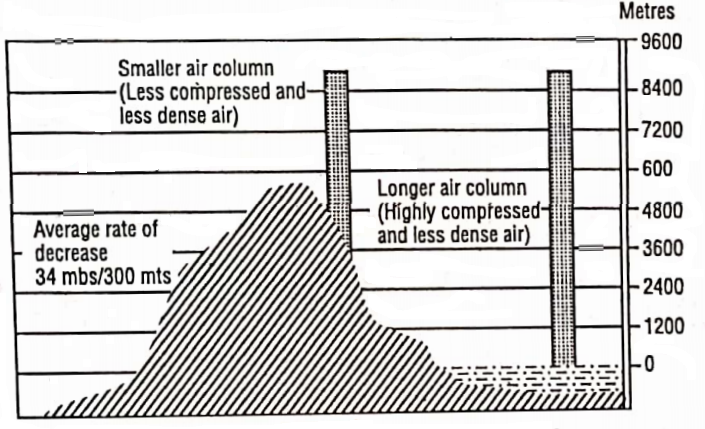
| Altitude in metre | Air Pressure in millibars |
| Sea Level | 1013.25 |
| 1000 | 898.76 |
| 2000 | 795.01 |
| 3000 | 701.21 |
| 4000 | 616.6 |
| 5000 | 540.48 |
| 10000 | 265 |
| 30000 | 11.85 |
It is estimated that about one-half of the atmospheric pressure lies up to a height of 5 km. There is a rapid decrease in pressure with increasing altitude. This fact is easily experienced by mountaineers.
Due to the drop in air pressure the boiling point of water drops in mountainous regions.
Their water starts boiling at a temperature below 100°C when the air pressure drops. So, it is difficult to ‘boil rice or anything for that reason.
As the air gets thinner with altitude oxygen in the air reduces too.
So, mountaineers experience breathing and other troubles while they are scaling high peaks.
Due to low pressure, blood oozes out of their nostrils and their lungs work feverishly. If the air pressure is very low the mountaineers fall down and lose consciousness.
So, mountaineers have to carry oxygen cylinders to breathe freely when they’ll travel to very high altitudes.
3. Water vapour / Moisture-laden air – Water vapour in the air, often called vapour concentration on moisture-laden air is lighter than dry air. Therefore, dry air is heavier than wet or humid air.
Due to this reason, land winds are heavier than sea winds which are laden with water vapour.
As a result, low air pressure is generated by moisture-laden air and high air. pressure is generated by the dry air.
4. Rotation of the Earth – The rotation of the earth also causes differences in pressure. The earth’s rotation leads to the sinking of air in certain places and the ascent of air in other places.
The earth’s rotation is responsible for the formation of the sub-tropical high-pressure belt and the sub-polar low-pressure belt in each hemisphere.
Classification of Air pressure: There are two types of air pressure-
- High Pressure and
- Low Pressure. High pressure and Low pressure mean the number of air molecules that is present in a definite volume of air.
1. High Pressure – If a definite volume of air has many air molecules the weight or pressure will be high. If the barometer has an air pressure level of 1013-25 millibars or more the condition is known as ‘High Pressure’.
2. Low Pressure – If a definite volume of air has few molecules, its weight or pressure will be low. If it is 986 millibars or less it means Low Air Pressure.
Chapter 3 Distinguish Between The High Air Pressure And Low Air Pressure
| High Air Pressure | Low Air Pressure |
| 1. Any pressure higher than the surrounding air pressure is called a ‘high air pressure’. | 1. Any pressure less than the surrounding pressure is called a ‘low air pressure’. |
| 2. A high-air pressure area is usually cold and compacted. | 2. A low air pressure area is usually warm, light and expanding. |
| 3. High air pressure is found in cold temperate and polar regions. ‘ | 3. Low air pressure is found in the Equatorial and tropical regions. |
| 4. In high air pressure areas cold and heavy air naturally sinks towards the earth’s surface, gets denser and exerts higher pressure. | 4. In low air pressure areas warm and light air rises upwards and the ascent of air creates low pressure. |
| 5. In high-air pressure areas air is generally cold, dense and dry. | 5. In low-pressure areas air is generally hot and humid. |
| 6. Generally calm weather and clear sky prevail in high air pressure | 6. Cloudy, rainy, stormy and turbulent weather prevails in low-air pressure areas. |
Measurement Of Air Pressure :
The normal or standard air pressure at sea level is 1013-25 Mb (millibar). The unit of the force to measure air pressure is called a ‘bar’. A ‘bar’ is divided into 1000 millibars.
Millibar is a force equal to 1000 dynes per cm2 whereas a dyne is a unit of force approximately equal to the weight of one milligram or 29.92 inches or 76 cm.
At a temperature of 15° C at the latitude of 45. The common unit to measure air pressure is a millibar. Actual air pressure on the earth’s surface is found to vary between 940 and 1040 millibars.
Relation Between Different Units Of Air Pressure :
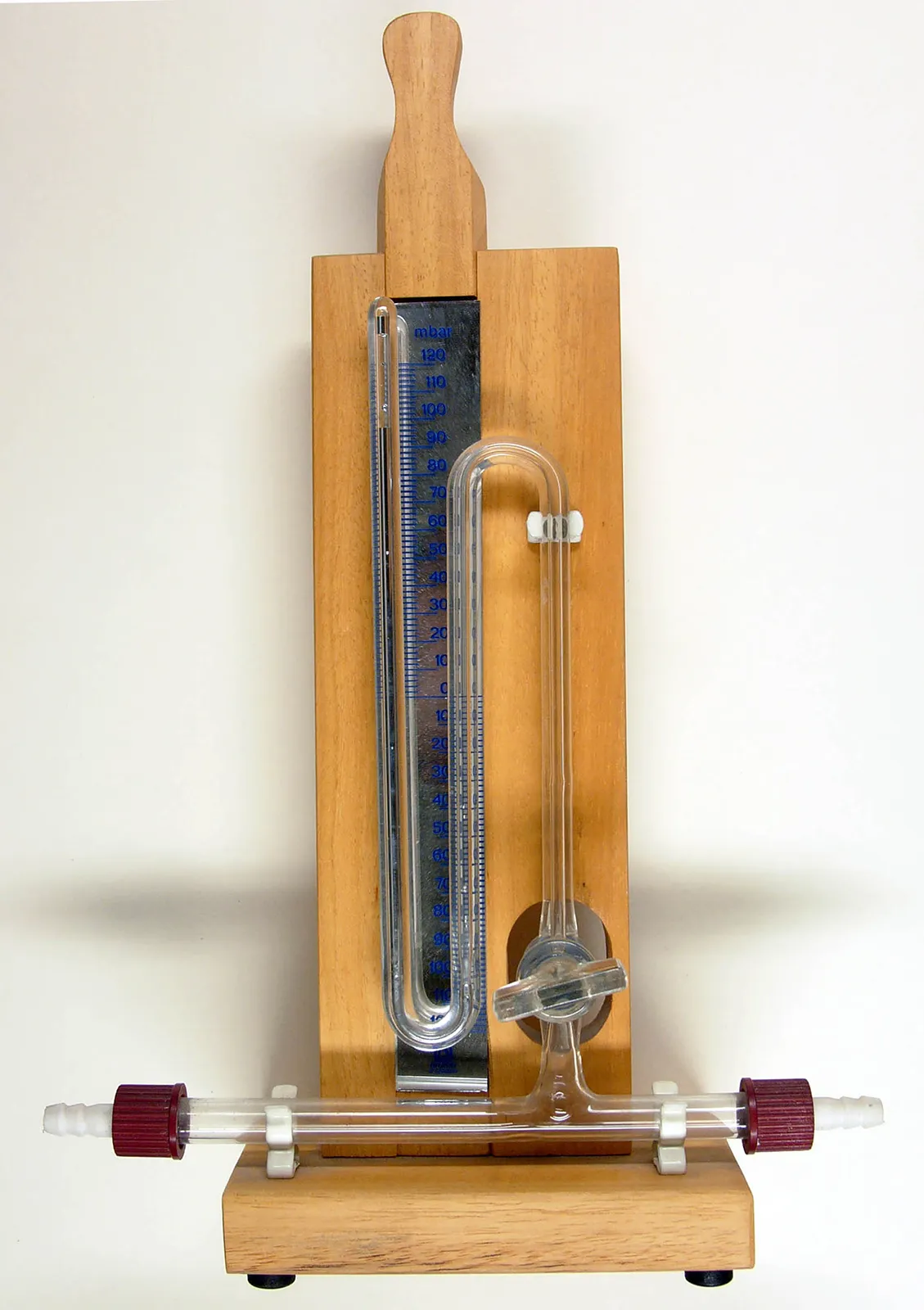
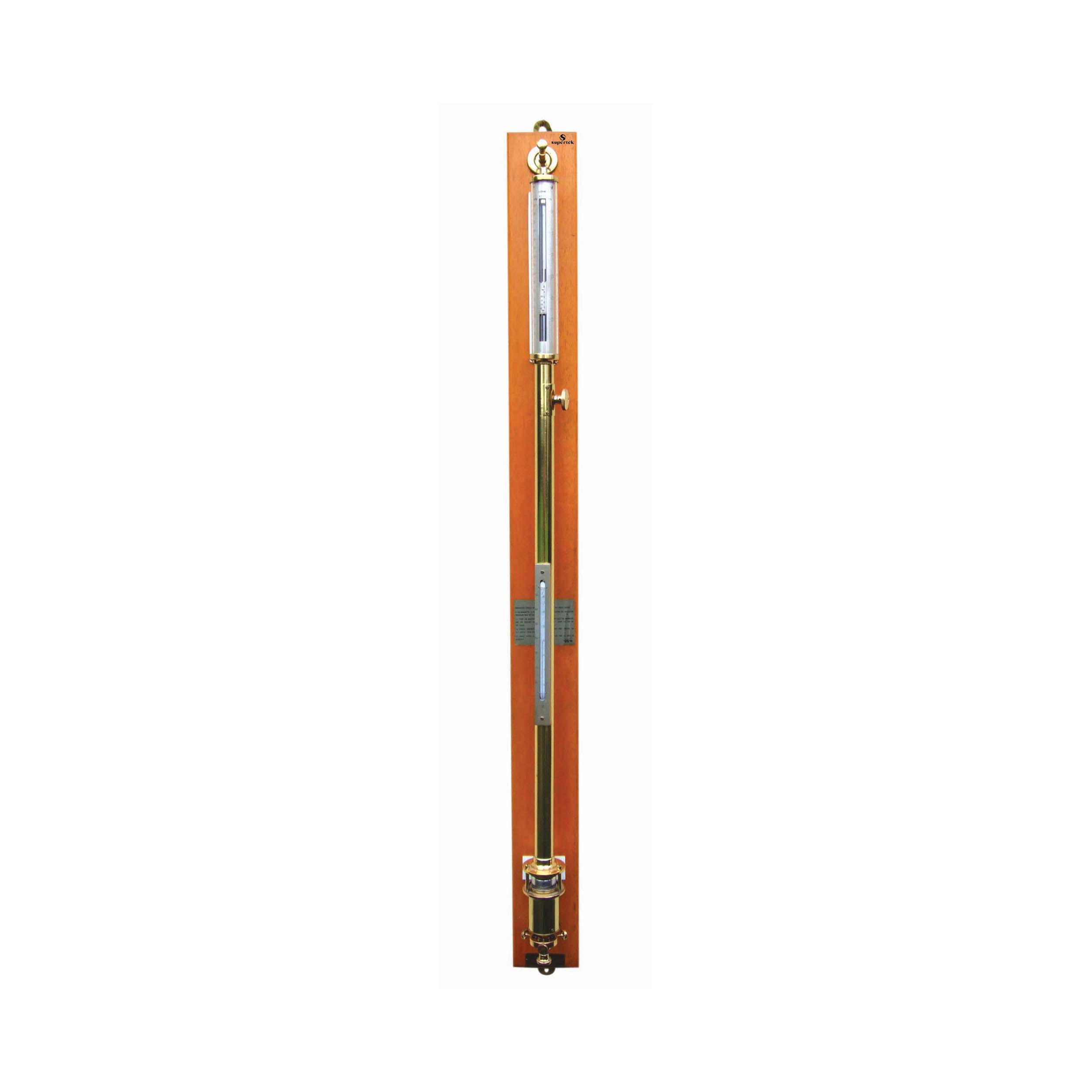
29.92 inches 1 inch
76 cms 1013-25 millibars
33-86 MB or 34 MB
1 cm = 13.3 MB.
The instrument used to measure air pressure is called a ‘barometer’. It was Torricelli, a disciple of Galileo, who first partially measured air pressure in 1643.
The simplest but most accurate instrument used for measuring air pressure is a mercury barometer.
It consists of a long narrow glass tube filled with mercury.
The tube is inverted and immersed in a vessel containing mercury. The pressure of the atmosphere on the mercury in the vessel is able to balance mercury.
Column of 76 cm in height. The mercury column is acting as an instrument for measuring the air pressure. Mercury is used in the barometer because it is the densest liquid.
This instrument is called an Ordinary Barometer or Torricellian Barometer. The most common barometer using mercury is called ‘Fortin’s barometer’.
Fortin reformed the ‘Ordinary Barometer’ to construct a better barometer. This barometer measures the air pressure very correctly but it has to be kept hanging by a nail in contact with the wall.
It is not convenient to take the barometer from one place to another. Nowadays air pressure is easily measured by an improved handy portable instrument called the Aneroid barometer.
An Aneroid barometer consists of a flat metal box with a vacuum chamber with expands or contracts as the air pressure changes.
The movements are picked up by levers which move the needle on the face of the instrument.
It can be taken easily for fieldwork. So mountaineers, aircraft pilots and most other people use this barometer to find both air pressure and height climbed.
The continuous changes in air pressure are recorded by means of a curve drawn or scaled paper called a ‘barogram’.
A ‘barograph’ is a self-recording instrument which records changes in pressure by a curve on graph paper mounted on a rotating drum.
The altimeter is an instrument which helps to read the altitude of a place directly from its dial.
It works on the principle that the air pressure falls with altitude at a rate of about.11 MB per 100 metres of height.
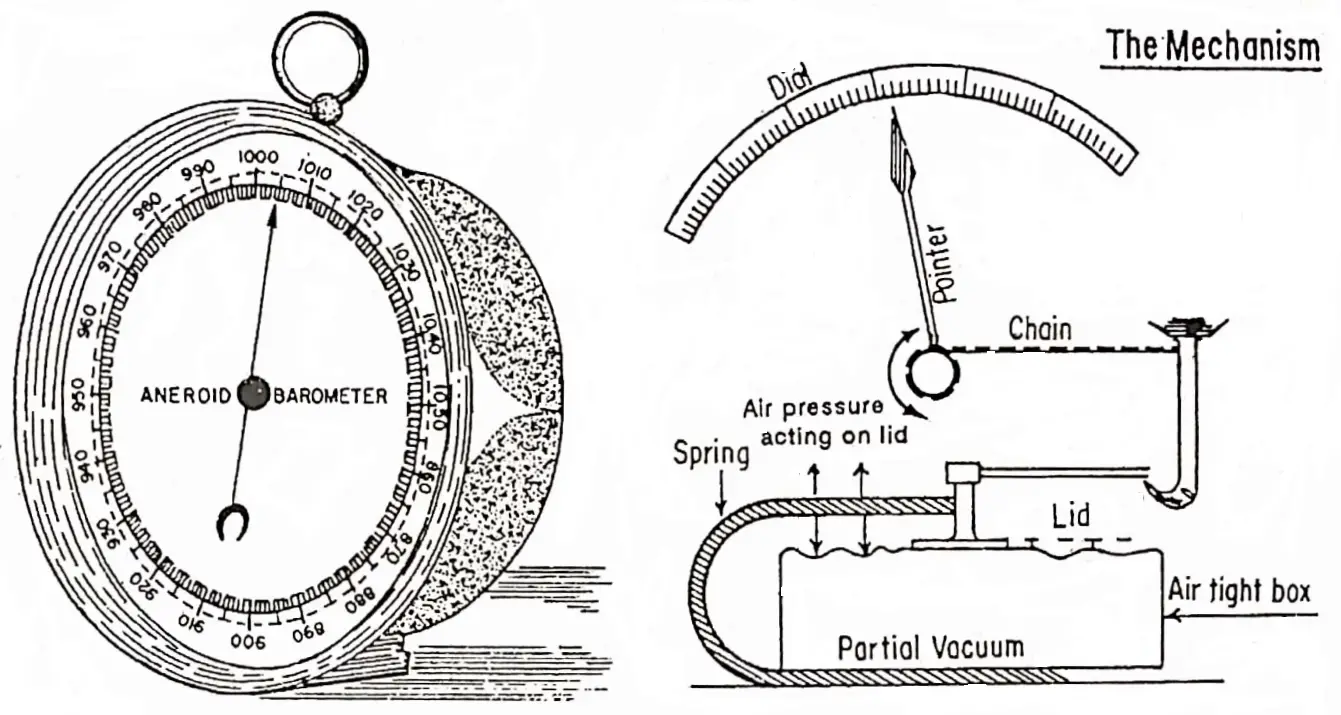
Distribution Or Variation Of Air Pressure On The Earth :
Distribution or variation in air pressure in the atmosphere is not uniform over the earth’s surface. It varies vertically as well as horizontally.
Vertical Distribution Of Air Pressure :
The pressure exerted below from the overlying layers of air or that exerted from above to the air below is called vertical air pressure.
Near the earth’s surface air pressure is very high because it has to withstand the weight of the overlying layers of air.
Thus the air pressure gradually decreases upwards from the earth’s surface. In general, the air pressure decreases on an average at the rate of about 34 millibars per every 300 meters of height.
Horizontal Distribution Of Air Pressure :
The pressure exerted by moving horizontally is called horizontal air pressure. The distribution of air pressure across the latitudes is termed global horizontal distribution.
Its main feature is its zonal character known as ‘Pressure belts’.
On the earth’s surface, there are in all seven pressure belts.
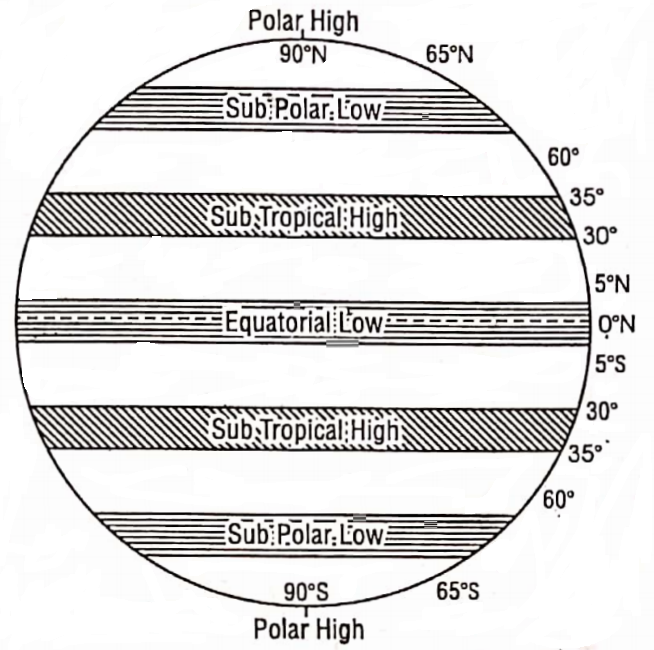
Chapter 3 Isobar
Isobar is a combination of two words (Iso Equal and Bar Pressure). So isobars are linesIsobar is an imaginary line joining the places of equal air pressure at a particular time reduced to sea level.
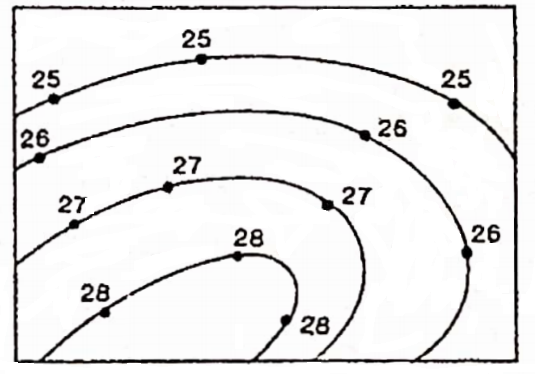
If a place is 300 metres high and its actual pressure is 900 MB. Its pressure reduced to sea level would be 900+34 934 millibars because the pressure decreases at the rate of 34 millibars for every 300 metres.
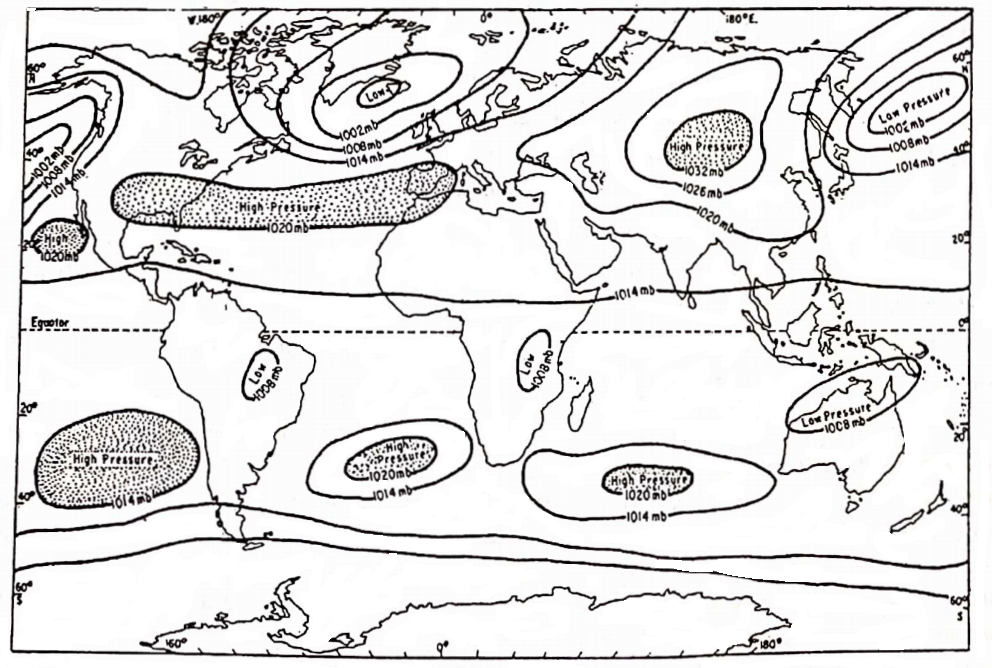
Characteristics of Isobars :
- The Isobars generally run in an east-west direction.
- The Isobars do not intersect or meet each other.
- These are more regular in oceans than on land.
- The Isobars represent air pressure measured in millibars.
- These separate areas of high pressure from areas of low pressure.
- The Isobars are used to show the distribution of pressure on weather climatic maps.
- In the southern hemisphere, these closely follow the line of latitudes.
- The spacing of isobars shows the direction and velocity, of wind pressure
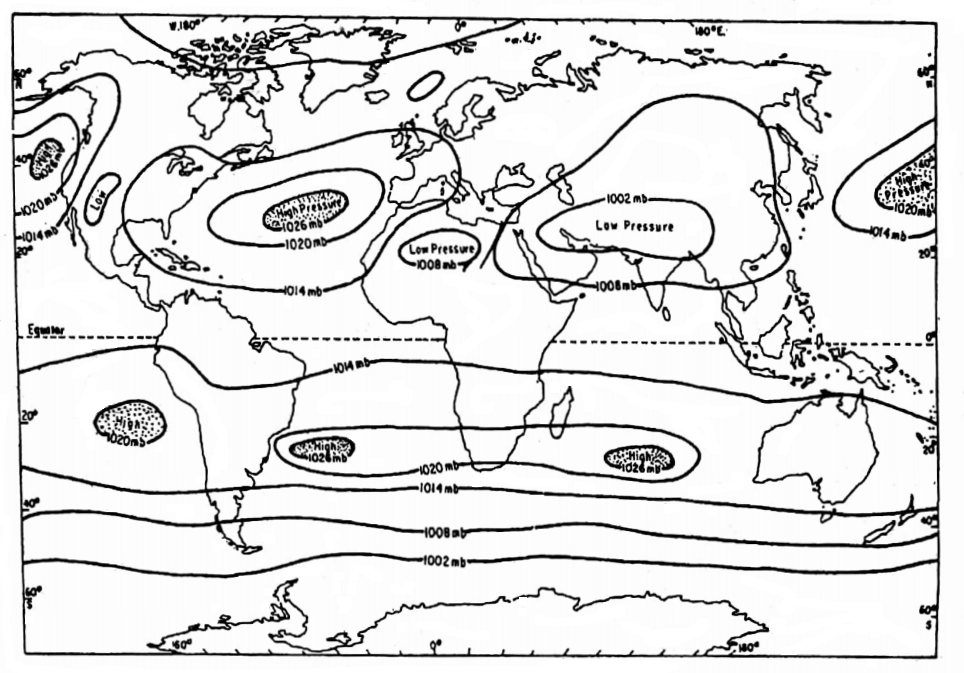
Chapter 3 Air Pressure And Movement Of Air
The study of air pressure patterns on the globe is important as it is directly responsible to make the air move. It also decides the direction and pace of the movement of air.
Air moves from an area of high pressure to an area of low pressure.
The rate of change of the air pressure between two points on the earth’s surface is known as the ‘pressure gradient’.
When the movement of air is horizontal it is called wind. The wind velocity is high in an area of steep pressure gradient and it is low in an area of a gentle pressure gradient.
When the movement of air is vertical or nearly so, it is called an air current.
The direction of the wind is also influenced by the rotation of the earth.
The direction of the planetary winds is affected by the earth’s rotation and follows a simple pattern.
Periodical winds are felt only during certain times or during certain parts of the year. Local winds circulate over a comparatively small area.
Variable winds are mainly two types-Cyclones and anticyclones.
Winds rush towards the depression from all directions, called cyclones; they bring bad weather, rain storm, hail and snow which sometimes cause widespread destruction and loss of life. Anti-cyclones are gentle and bring fair weather with them.

